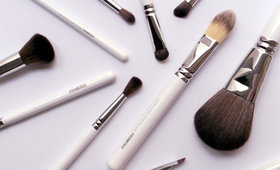
I will always remember my first Fude. They were from the esteemed manufacturer, Hakuhodo. When I started my blog in 2012, sometimes I would reach out to them if I had a question. As time passed, our connection turned into a friendly relationship. One day they told me that I could come to their factory in Kumano, Japan (the makeup brush capital of the world) and visit them. It was after this meeting when everything escalated so quickly for me. All the brushes I purchased, all the people I met, I could never have imagined where it would take me.
Having my own brand now is still unbelievable to me, but one of the things that I appreciate the most is that I can still go to Kumano and spend time with the artisans and all the people working there. Keeping this connection with all the manufacturers in Kumano is very important to me.
So, I asked my contact Sakiko Taniguchi, the General Manager of Sales, if I could ask her a few questions about Fude today: the evolution, the demand, the reasoning behind the selection of the bristles, and more. I am happy to be able to share her answers with you all!
Thank you for reading, and a huge thank you to Sakiko and everyone at Hakuhodo for kindly answering these questions and always being so welcoming!
Please tell us where you are established and what type of make-up brushes or tools do you design and manufacture today?
Hakuhodo was founded in 1974 by Kazuo Takamoto, a fourth-generation brush maker and president of the company, in Kumano Town, Hiroshima Prefecture, which has a history of about 200 years of brush making.
Utilizing traditional techniques, we produce a wide variety of brushes, including makeup brushes, traditional brushes for drawing Japanese dolls, traditional craft brushes used for painting porcelains and lacquer wares, calligraphy brushes, painting brushes, and industrial brushes.
Do the techniques and skills required to manufacture calligraphy/painting brushes, and makeup brushes share some similarities?
Calligraphy brushes/painting brushes (collectively known as Menso brushes) and makeup brushes are manufactured in different ways. Each Menso brush is handmade by a craftsman using a traditional process.
For makeup brushes, we divide the production into smaller processes, using appropriate tools and traditional processes. This helps us to efficiently mass produce brushes that are still manufactured by hand.
What about natural versus synthetic makeup brushes—do they involve similar techniques or challenges? What types are the most difficult to bundle?
There is no big difference in the manufacturing process between natural hairs and synthetic fibers, but the characteristics of the hairs are different, so even if they are made in the same techniques/processes, the shapes and functions will be different.
If we simply replace natural hairs with synthetic fibers, the shape may be similar, but the function may not be fulfilled. Sometimes even the shape may be different.
When creating the same types of brush in natural and synthetic versions, we devise the structure of the hair blend. Whether natural or synthetic fibers, we consider all to be raw materials. By understanding the characteristics of the hair and fibers, we can select the blend according to the function each brush should provide.
Where is there more demand today: in natural brushes or synthetics?
The demand for synthetic fibers is steadily increasing as they are easier to import/export, involve less shedding, dry quickly after washing, and are for people who do not use animal products.
The supply of animal hair is unstable, and there are restrictions on import and export. However, since some natural hairs are essential for specific uses, natural hair products are still very popular with our customers.
I recently heard a calligraphy Fude artisan say that the quality of natural goat bristles is decreasing. Have you also noticed this?
Obtaining high-quality raw goat hairs from farms has become harder and harder compared to decades ago. The number of people who consume goats as food is decreasing, so accordingly, farming is also decreasing.
With regards to natural goat bristles, are there any ways to mitigate either the changes in quality or the availability of natural bristles?
Unfortunately, we cannot control the quality of the raw goat hair itself, so we sort the hair we obtain based on its characteristics.
In the past, names such as saikoho and sokoho were used to describe hair quality, but these names are just based on the part of the hair—they do not confirm quality.
Rather, the quality and characteristics vary depending on the length of the hair and when it is harvested. Regardless of the name, we maintain the quality of our products by sincerely understanding and selecting raw hair characteristics and blending several types of hairs, as necessary.
Are your synthetic fibers made in Japan?
There are various types of synthetic fibers. We purchase synthetic fibers from China, Thailand, Japan, etc., then select and blend them at our factory.
When you design a new makeup brush, how do you decide which blend of fibers will go on that brush?
The core of our development is expressed in Hakuhodo’s mission: ‘‘Our brush is ultimate Fude, the perfect tool.’’ (Fude is a Japanese word for brush)
For makeup, it is essential that it feels nice. However, even if it is comfortable on the skin, it is meaningless if the makeup does not finish the way you want it to, so all our brushes are developed in pursuit of how easily, quickly, and beautifully makeup can be applied. The brush should consider the structure of the bristles.
For example, some of our customers may have doubts about adding synthetic fibers with natural hairs, but blending a certain amount of synthetic fibers with goat hair can improve powder release, increase stiffness, improve shape retention, and improve skin feel. Blending several types of hairs may improve quality. (Of course, 100% of the same hair is sometimes better for some brushes!)
We strive to improve quality by creating ingenuity and the best blends of hair and structure for each brush.
When I talk to someone who is new to Fude I can feel that they are often scared they will damage them. What are your recommendations for someone who is just starting their Fude journey?
The best way to take care of our makeup brushes is to use them every day and properly care for them before and after each use to restore them in good condition.
Before using large brushes such as powder or blush brushes of any type of bristles, dust them with the palm of your hand until the brush head makes a flapping sound so that the brush becomes air-filled and hairs line up neatly on the surface. After use, dust off in the same way. (See video at the end of the article for a demonstration)
For small brushes or brushes for liquid/creams, use a soft towel to wipe them in one direction along the flow of the hairs.
Join us in Sonia’s Fude Corner where brush designer and connoisseur Sonia G. shares expertise and knowledge about handcrafted Fude. Sign up here to get notified about Sonia’s newest articles.
You Might Also Like
-

Interviews
How to Give Your Man a Makeover: Brows
- 23
-

Makeup & Travel Bags
A Makeup Artist’s Travel Beauty Checklist
- 761
-

Makeup Brushes
Everything You Need to Know About Vegan Makeup Brushes
- 349
-

Makeup
Fall Forecast: Makeup Trends
- 93
-

Fashion
Snooping Inside A Fashion Editor's NYFW Handbag
- 13
-

Industry Interviews
Real Talk: Beautylish Gets Down to Earth With Top Model Nicole Fox
- 97









